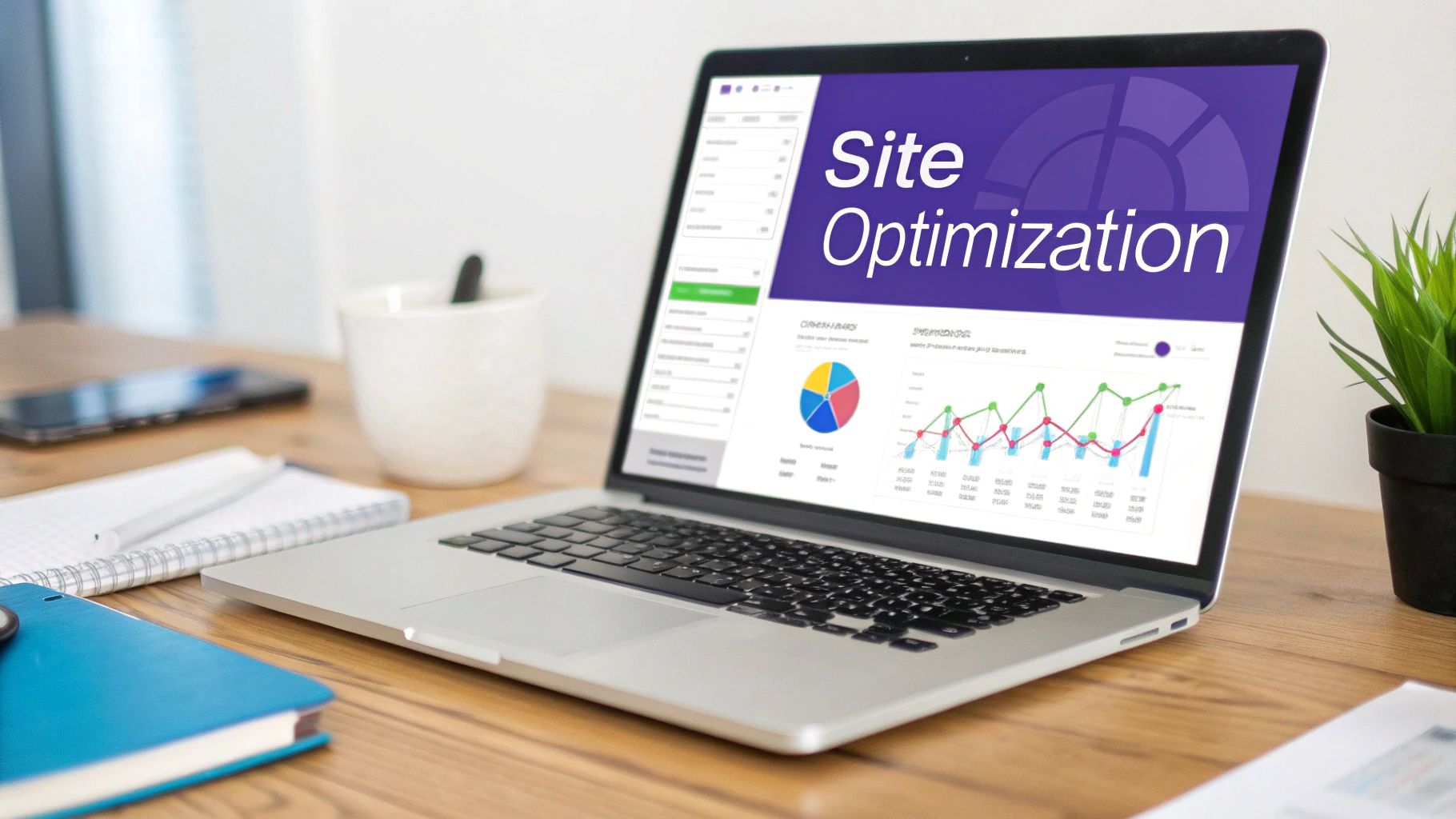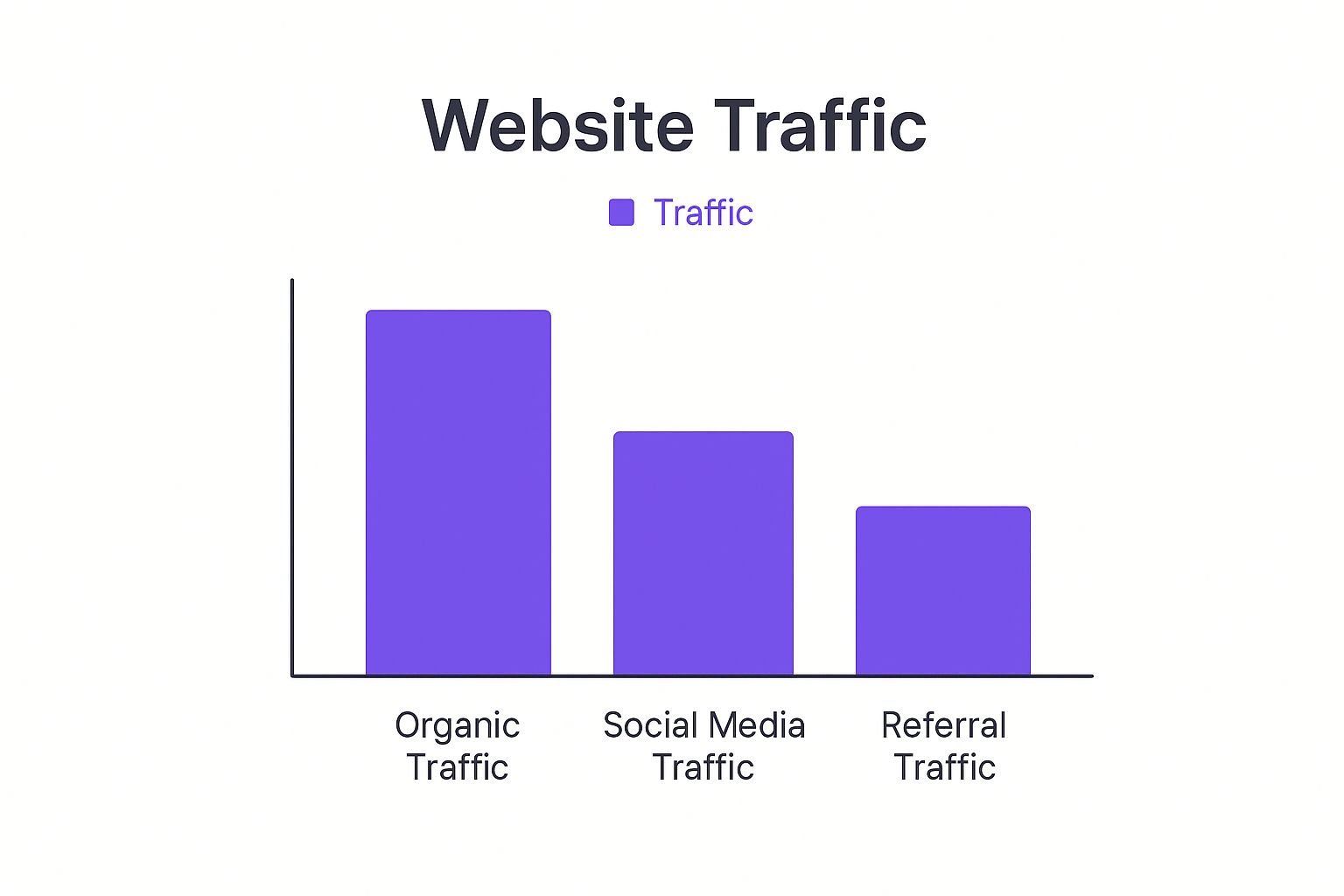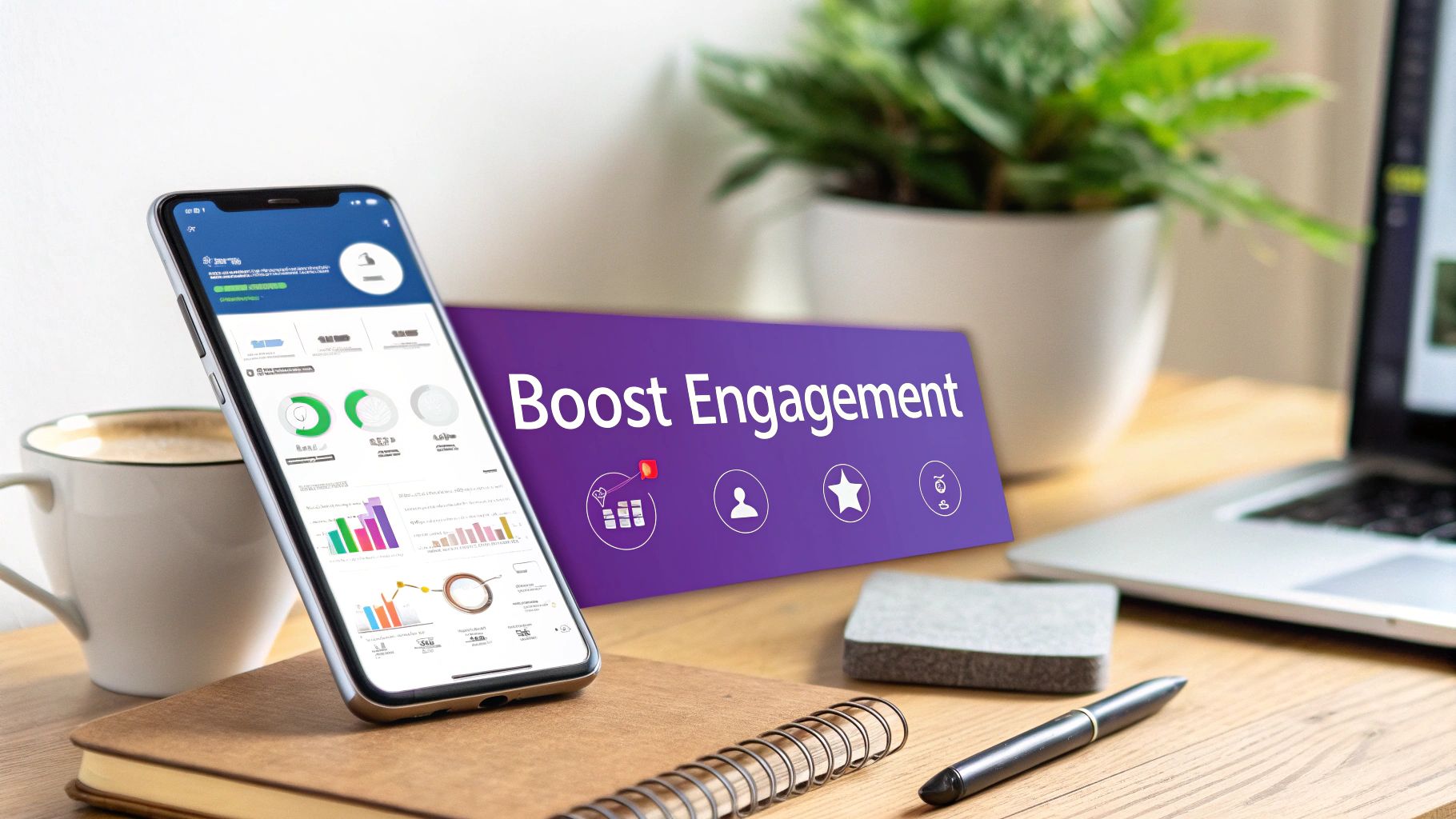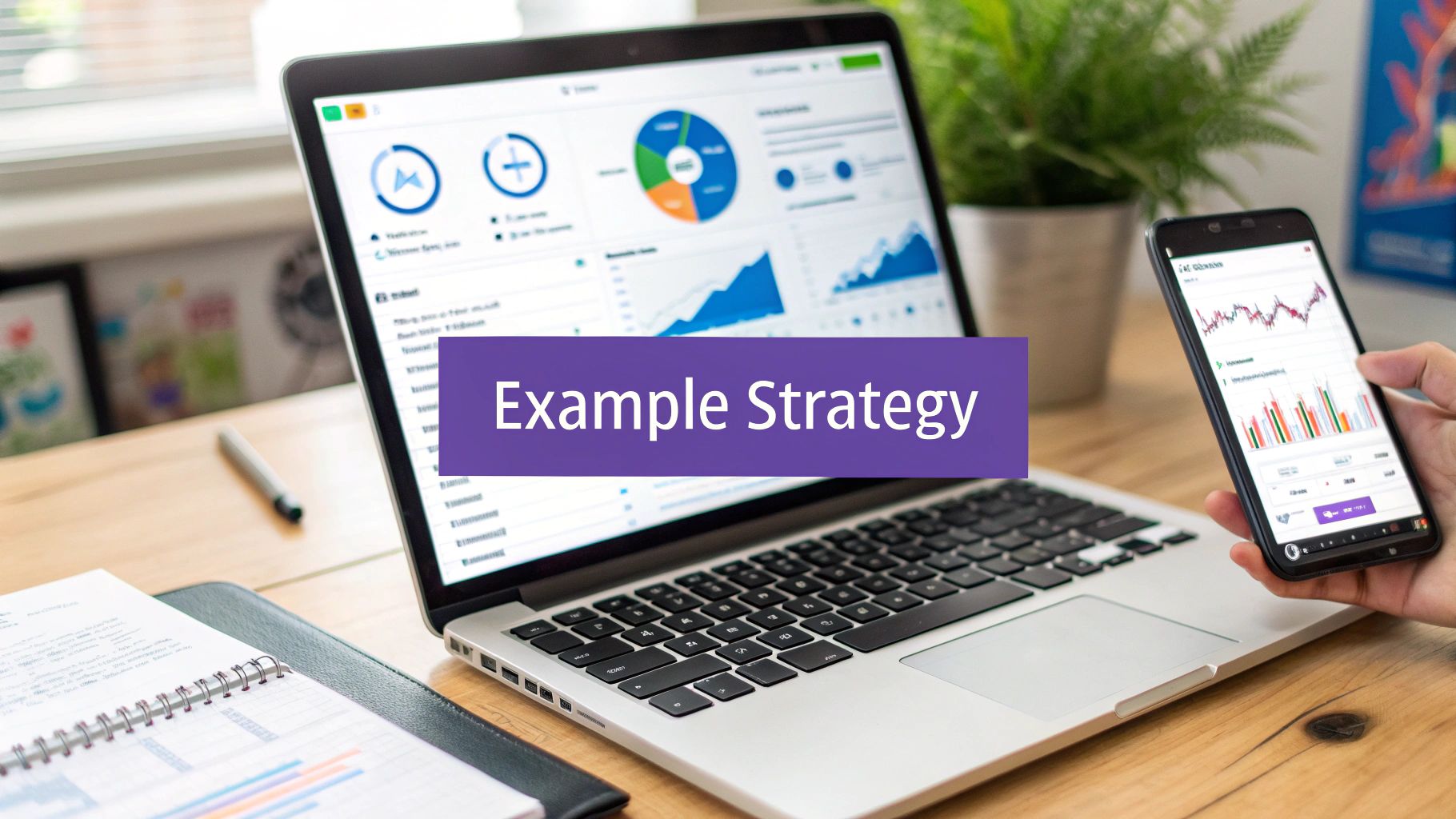Enhance Online Presence: Your Business Growth Game Plan

Finding Your Starting Point in the Digital Landscape
Before you can build a stronger online presence, you need a clear picture of where you currently stand. Diving into a self-audit might sound technical, but it’s really just about asking the right questions to understand your digital footprint. I once worked with a local bakery owner who thought her Facebook page was her main online asset. A quick audit revealed an old, unmanaged Yelp profile with negative reviews was the first thing potential customers saw in search results.
This initial assessment isn’t about getting lost in data; it’s about gaining clarity. The goal is to honestly evaluate how you appear across different channels to see what’s working and what’s holding you back. A simple audit can uncover surprising gaps and opportunities you didn't know you had.
Perform a Simple Self-Audit
Start by putting yourself in a customer's shoes and searching for your business name on Google. What appears on the first page? Is it your website, your social media profiles, or third-party directory listings? For instance, search results are often a mix of different content types, not just websites.

This simple search shows that your online presence is a combination of your own assets and what platforms like Google choose to highlight about you. Make a list of everything you find and ask yourself a few critical questions:
- Is my business information (name, address, phone number, and hours) consistent everywhere it appears?
- Do the photos and branding accurately reflect my current business?
- What is the general tone of the reviews and comments I'm seeing?
Answering these questions gives you a solid baseline. It helps you prioritize which areas need immediate attention to build a more cohesive and powerful online identity, turning your digital existence into a true presence that attracts customers.
To help you get started, I've put together a checklist that breaks down what to look for when auditing your digital assets. This table will guide you through evaluating each part of your online presence, from your website to your social media profiles.
| Digital Asset | Assessment Criteria | Tools to Use | Success Indicators |
|---|---|---|---|
| Website | - Mobile-friendliness - Page speed - Up-to-date content - SEO keyword performance |
- Google's Mobile-Friendly Test - PageSpeed Insights - Google Search Console |
- High mobile usability score - Fast load times (<3 seconds) - Ranking for relevant keywords |
| Social Media | - Profile completeness (bio, links) - Consistent branding - Audience engagement rate - Tone of comments/reviews |
- Native platform analytics - Buffer or Hootsuite |
- Consistent visual branding - Positive sentiment in comments - Regular, meaningful interactions |
| Local Listings | - NAP (Name, Address, Phone) consistency - Accuracy of business hours - Quality and recency of reviews |
- Google Business Profile - Yelp for Business |
- Identical NAP across all listings - High average star rating (>4.0) - Recent positive reviews |
| Search Engine Results | - First-page search rankings - Online reputation (reviews, articles) - Brand vs. competitor visibility |
- Incognito Google search - Semrush or Ahrefs |
- Your website is a top 3 result - Positive articles or mentions appear - Minimal negative search results |
This checklist provides a structured way to approach your audit. By systematically reviewing each asset, you can pinpoint specific areas for improvement and create an actionable plan to strengthen your digital presence.
Building Your Digital Foundation That Actually Converts
Think of your website as more than just a digital business card. It's your hardest-working employee, operating 24/7 to bring in business. To truly enhance your online presence, your site needs to do more than just exist—it must turn visitors into loyal customers. I’ve spoken with countless business owners who initially poured their budget into flashy designs, only to discover a clunky user experience was quietly bleeding leads. The most successful websites I’ve seen always prioritize function over flair, guiding visitors on a clear and simple journey.
This focus on performance over pure aesthetics is a major trend in business promotion. The global advertising world has shifted massively toward digital channels, with online ad spend expected to rocket past $790 billion in 2024. This means digital advertising now makes up 72.7% of all ad investments worldwide, making a high-performing website more critical than ever. You can learn more by exploring these global advertising trends to grasp the full picture.
Focus on Speed and User Experience
A website that actually converts is a fast and smooth one. A slow, frustrating site is the digital equivalent of a locked door—potential customers will simply leave. One of the first things you should check is your page speed, as it has a direct effect on both user happiness and how you rank in search engines.
Here's an example of what Google's PageSpeed Insights tool shows when it analyzes a website's performance.

This analysis breaks down specific performance areas, like Core Web Vitals, giving you a clear score and practical suggestions for improvement. A high score means your visitors are having a seamless experience, which makes them much more likely to stick around, explore your offerings, and ultimately make a purchase. Making these technical aspects a priority is a fundamental step in building a website that actively grows your business.
Creating Content That Your Audience Actually Wants
Are you tired of pouring time and energy into blog posts or videos only to be met with silence? It’s a common frustration. To build a real connection online, you need to stop guessing what your audience wants and start listening. The goal is to create content that answers their questions, solves their problems, and positions you as a trusted expert. Think of yourself as a helpful guide, not just another voice shouting into the void.
I once worked with a financial planner who was writing generic blog posts about retirement. They were getting almost no views. After a few conversations with her clients, she discovered their most pressing concern was figuring out how to pay for their kids' college tuition. She shifted her content to focus on topics like "saving for college while managing debt," and her engagement went through the roof. That’s the power of creating content that truly serves your audience.
Pinpointing Topics That Resonate
The best content ideas are often hiding in plain sight, right within your existing community. You just need to know where to look. Here are a few practical ways to uncover what your audience is curious about:
- Check your social media comments and DMs. What questions pop up over and over again? These are content goldmines.
- Chat with your customer service team. They are on the front lines every day and have a direct line to your customers' biggest challenges and frustrations.
- See what's popular in your niche. Look at what your competitors are doing well, but more importantly, look for the gaps. What questions aren't being answered? Fill that void with your unique perspective.
Once you have a list of solid topics, think about the best way to present them. A deep, complex subject might be perfect for an in-depth blog post or guide. A quick tip, on the other hand, could be a great fit for a short video. Tools like Canva can help you visualize how your ideas might look in different formats.

As you can see, having access to different templates makes it easier to match your message with the right format, whether it's a social graphic or a full presentation.
Adapting to New Content Formats
The way people find and consume information is always changing. For instance, short-form video has become a dominant force. Recent trends show that platforms like TikTok, YouTube Shorts, and Instagram Reels are changing how people engage with digital content. According to Deloitte's digital media trends report, the rise of these platforms in early 2025 is a key factor impacting marketing strategies worldwide.
This shift presents a huge opportunity to connect with your audience on the platforms where they’re already spending their time. The most important thing is to be consistent and authentic. Focus on creating content that genuinely helps and engages your community, and you'll build a loyal following.
Making Social Media Work for Your Business Goals
Let’s be honest, social media isn't about creating the next viral dance video (unless that's your brand!). It's about building real, lasting relationships that actually help your business grow. A common trap is trying to be everywhere at once. It’s much smarter to dominate one or two platforms where your ideal customers hang out than to have a weak presence on five.
Think about it: a high-end B2B consulting firm will likely find more qualified leads by joining expert discussions on LinkedIn than by posting on TikTok. The goal is to match your platform choice with your business objectives, not just follow the crowd.
Choosing Your Channels and Content
Before you post anything, figure out where your audience is already having conversations. Are they asking for advice in local Facebook groups? Or are they following industry leaders and trends on X (formerly Twitter)? Once you know where they are, you can create content that genuinely serves them and sparks interaction. This is less about selling and more about helping.
Here are a few ideas to get you started:
- Showcase your expertise by creating posts that answer the most common questions you get.
- Provide amazing customer service by being quick and helpful when responding to comments and direct messages.
- Build a community by creating unique experiences that make your followers feel like they're part of something special.
To help you decide which platform is the best fit, here's a quick comparison of the major players and what they're good for.
Social Media Platform Comparison for Business
A detailed comparison of major social media platforms and their effectiveness for different business goals
| Platform | Best For | Content Types | Audience Demographics | Engagement Features |
|---|---|---|---|---|
| Community building, local businesses, broad audience reach | Videos, images, text posts, Stories, live streams | Wide range, slightly older demographic (35-55+) | Groups, Events, Messenger, Ads | |
| Visual branding, e-commerce, influencer marketing | High-quality images, Reels, Stories, carousels | Younger demographic (18-34), visually-driven | Shopping tags, Collabs, Reels Remix, DMs | |
| B2B networking, thought leadership, professional branding | Articles, text posts, case studies, professional videos | Professionals, B2B decision-makers, job seekers | InMail, professional groups, articles, polls | |
| X (Twitter) | Real-time news, customer service, brand voice | Short text posts, threads, images, videos, polls | Broad range, popular with news/tech/politics followers | Retweets, replies, Spaces (audio), polls |
| TikTok | Brand personality, user-generated content, trend-spotting | Short-form vertical videos, tutorials, challenges | Primarily Gen Z and younger millennials (16-24) | Duets, Stitches, comments, live video |
This table shows that there's no "one-size-fits-all" answer. The best platform for a local bakery (Facebook and Instagram) is very different from the best one for a software company (LinkedIn and X).
While organic search is a powerful tool for bringing people to your website, a solid social media plan gives you a direct line to your audience. This infographic shows how different traffic sources can work together.

Ultimately, building these authentic connections is what turns a casual follower into a loyal customer who champions your brand.
Getting Found When Your Customers Are Searching
Search Engine Optimization, or SEO, might sound overly technical, but at its heart, it’s about one simple thing: being the best answer when someone is looking for what you offer. It's how you show up for customers who are already searching for a solution. Think of it like a librarian who knows exactly which book to recommend. Your goal is to make it easy for search engines like Google to see that your business is the perfect "book" for the searcher's needs.
This process starts with getting inside your customer's head and figuring out what they’re actually typing into that search bar. I once worked with a personal trainer who was focused on the term "fitness coaching." After chatting with some of her clients, she discovered they were actually searching for things like "postpartum workout plans at home." By shifting her website's content to address that specific need, she started connecting with the right people.
Matching Search Intent with Your Content
The real key to effective SEO is aligning your content with search intent—the "why" behind every search. Is someone just gathering information, comparing their options, or are they ready to make a purchase? A fantastic tool for tracking how you're doing is the free Google Search Console.
This dashboard gives you a direct look at the search queries already leading people to your site. You can use this data to either lean into what's already working or uncover new opportunities you might have missed.
A solid SEO strategy is a crucial part of building a strong digital presence. The entire field is booming for a reason; the global digital marketing industry is expected to grow by 13.9% annually through 2025. This growth signals just how important effective online strategies have become. You can dig deeper into these numbers in this digital marketing industry analysis.
At the end of the day, good SEO isn't about playing games with algorithms. It’s about creating genuinely helpful content that solves real problems for real people. That’s what builds lasting visibility and earns trust with your audience.
Tracking What Matters for Your Business Growth
Numbers don’t lie, but they can easily confuse you if you're tracking the wrong ones. To truly build a strong online presence, you have to look past vanity metrics—things like follower counts or page likes—and concentrate on data that connects directly to business growth. It's easy to get lost in dashboards full of charts, but successful entrepreneurs know how to pinpoint the few key metrics that signal real progress.
From Data Overload to Actionable Insight
A great first step is to connect your website to a free analytics tool. You don't need to become a data scientist. The goal is simply to understand how your audience behaves. Are people finding your most important pages? How long are they sticking around? These questions offer insights that can shape your entire strategy.
For instance, a dashboard from a tool like Google Analytics provides a quick, visual summary of who is visiting your site.
This snapshot immediately tells you where your visitors are coming from and which pages are the most popular. Discovering that a specific blog post is driving most of your traffic is a powerful insight. It tells you exactly what kind of content connects with your audience, so you know what to create next.
This shift in focus—from just gathering data to using it for decisions—is what turns a stagnant digital footprint into a dynamic one. By tracking metrics like conversion rates (how many visitors sign up for your newsletter, for example) and user engagement, you create a feedback loop that continually refines your online efforts.
Your Action Plan for Online Presence Success
Success isn't about having a perfect strategy from day one; it's about taking consistent, focused action. This plan is your practical roadmap, turning everything we've talked about into a clear path you can follow. The key is to commit to small, steady efforts instead of trying to overhaul everything at once. This approach prevents burnout and helps you build real momentum.
Prioritize and Execute
To truly improve your online presence, it's best to focus on one or two key areas at a time. If your website audit uncovered some big problems, start there. If your content isn't hitting the mark, then your first move should be digging into audience research and creating material they'll actually find valuable.
- For New Businesses: Your priority is building a solid foundation. Get your Google Business Profile verified, create a fast and user-friendly website, and pick just one social media platform to really get good at.
- For Established Businesses: Now's the time to look for optimization opportunities. Dive into your analytics to see what’s already working, try out new content formats like video, and sharpen your SEO to attract customers with more specific needs.
Maintain Momentum and Adapt
Digital trends are always shifting, but that doesn't mean you have to chase every shiny new thing. A better approach is to schedule a quarterly check-in to review your progress. Ask yourself: What worked? What fell flat? What are my analytics telling me?
This regular review keeps your strategy sharp without pulling you in a million different directions. It’s all about making thoughtful adjustments, not just reacting to the latest fad. This sustained, intentional effort is what builds a powerful online presence that genuinely drives business growth.
Ready to transform your professional profiles in minutes? With MakerBox, you can generate optimized bios, profile photos, and social media content that gets noticed. Stop guessing and start building a presence that delivers results. Discover how MakerBox can elevate your career or business today.





